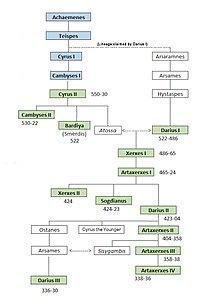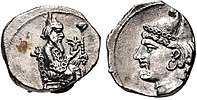This is an old revision of this page, as edited by HistoryofIran (talk | contribs) at 20:07, 9 March 2019. The present address (URL) is a permanent link to this revision, which may differ significantly from the current revision.
Revision as of 20:07, 9 March 2019 by HistoryofIran (talk | contribs)(diff) ← Previous revision | Latest revision (diff) | Newer revision → (diff)| This article or section is in a state of significant expansion or restructuring. You are welcome to assist in its construction by editing it as well. If this article or section has not been edited in several days, please remove this template. If you are the editor who added this template and you are actively editing, please be sure to replace this template with {{in use}} during the active editing session. Click on the link for template parameters to use.
This article was last edited by HistoryofIran (talk | contribs) 5 years ago. (Update timer) |
| Artaxerxes IV Arses | |||||
|---|---|---|---|---|---|
| King of Kings Great King King of Persia Pharaoh of Egypt King of Countries | |||||
 Probable portrait of Arses, wearing the Egyptian Pharaonic crown. Probable portrait of Arses, wearing the Egyptian Pharaonic crown. | |||||
| King of Kings of the Achaemenid Empire | |||||
| Reign | 338–336 BC | ||||
| Predecessor | Artaxerxes III | ||||
| Successor | Darius III | ||||
| Pharaoh of Egypt | |||||
| Predecessor | Artaxerxes III | ||||
| Successor | Darius III | ||||
| Died | 336 BC | ||||
| |||||
| Dynasty | Achaemenid | ||||
| Father | Artaxerxes III | ||||
| Mother | Atossa | ||||
| Religion | Zoroastrianism | ||||

Artaxerxes IV Arses (/ˌɑːrtəˈzɜːrksiːz/; Template:Lang-peo Artaxšaçā), was king of kings of Persia between 338 BC and 336 BC. He is known as Arses in Greek sources and that seems to have been his real name, but the Xanthus trilingue and potsherds from Samaria report that he took the royal name of Artaxerxes IV, following his father and grandfather.
Name
Arses is the Greek form of the Old Persian Aršaka (also spelled Aršāma, Xšayaaršan). The common Iranian variant is attested in Avestan Aršan- (linguistically related to Greek arsēn "male, manly").
Biography
Arses was the youngest son of Artaxerxes III and his wife Atossa. Arses had several brothers, only one whose name is attested, a certain Bisthanes. Persia was experiencing a resurgence under Artaxerxes III, who reorganized his empire, and suppressed revolts throughout the country. However, the fortunes of Persia came to an abrupt end in autumn of 338, when Artaxerxes III was murdered by the ambitious eunuch and chiliarch Bagoas, who had the king poisoned. Artaxerxes III's early death proved to be a problematic issue for Persia, and may have played a role in the weakening of the country. The majority of Artaxerxes III's sons, with the expection of Arses and Bisthanes, were also murdered by Bagoas. Bagoas, who wanted to be kingmaker, put the young Arses on the throne.
On his ascension to the throne, Arses most likely assumed the regnal name of Artaxerxes IV. He was put on the throne by Bagoas due to his youth, which the latter sought to take advantage of in order to control him. Around the same period, most of the Greek city-states had joined the Greek league under the leadership of the Macedonian king Philip II, who took advantage of the events in Persia by demanding compensation from the country for helping the town of Perinthus during the reign of Artaxerxes III. Arses declined, and as a result, a Greek expedition was started with Philip II was general, who sent 10,000 Macedonian soldiers into Asia in 336 BC. At the same time, however, Arses was focused on trying to free himself from Bagoas' authority and influence; he made an unesuccessful effort to have the latter poisoned, only to be poisoned himself along with the rest of his family by Bagoas, who put Arses' cousin Darius III on the throne. Macedonian propaganda, made in order to legitimize the conquests of Alexander the Great a few years later, accused Darius III of playing a key role in the murder of Arses, and portrayed the latter as the last king of the Achaemenid royal house.
Coinage
There is no dynastic coinage of Artaxerxes IV, but it is thought he may be depicted as a young ruler wearing the Pharaonic crown on the reverse of some of the contemporary coinage of satrap Mazaios in Cilicia.
-
 Another similar coin. Mazaios, Satrap of Cilicia, 361/0-334 BC
Another similar coin. Mazaios, Satrap of Cilicia, 361/0-334 BC
-
 Another similar coin. Mazaios, Satrap of Cilicia, 361/0-334 BC
Another similar coin. Mazaios, Satrap of Cilicia, 361/0-334 BC
-
 Coin of Cilicia 343-332 BC, thought to represent Artaxerxes III on the obverse, and a young Artaxerxes IV on the reverse, both wearing the Pharaonic crown.
Coin of Cilicia 343-332 BC, thought to represent Artaxerxes III on the obverse, and a young Artaxerxes IV on the reverse, both wearing the Pharaonic crown.
References
- ^ LeCoq 1986, p. 548.
- ^ Schmitt 1986, pp. 658–659.
- Waters 2014, p. 197.
- Briant 2002, p. 769.
- Briant 2002, p. 770.
Bibliography
Ancient works
- Arrian, The Anabasis of Alexander.
- Diodorus Siculus, Bibliotheca historica.
- Justin, Epitome of the Philippic History of Pompeius Trogus.
Modern works
- Schmitt, R. (1986). "Artaxerxes III". Encyclopaedia Iranica, Vol. II, Fasc. 6. pp. 658–659.
{{cite encyclopedia}}: Invalid|ref=harv(help) - LeCoq, P. (1986). "Arses". Encyclopaedia Iranica, Vol. II, Fasc. 5. p. 548.
{{cite encyclopedia}}: Invalid|ref=harv(help) - Waters, Matt (2014). Ancient Persia: A Concise History of the Achaemenid Empire, 550–330 BCE. Cambridge University Press. pp. 1–272. ISBN 9781107652729.
{{cite book}}: Invalid|ref=harv(help) - Briant, Pierre (2002). From Cyrus to Alexander: A History of the Persian Empire. Eisenbrauns. pp. 1–1196. ISBN 9781575061207.
{{cite book}}: Invalid|ref=harv(help)
| Arses of Persia Achaemenid dynastyBorn: ?? Died: 336 BC | ||
| Preceded byArtaxerxes III | Great King (Shah) of Persia 338 BC – 336 BC |
Succeeded byDarius III |
| Pharaoh of Egypt XXXI Dynasty 338 BC – 336 BC | ||
| Median and Achaemenid kings | |
|---|---|
| Family tree | |
| Median (728–550 BC) | |
| Achaemenid (550–330 BC) |
|
| Italics indicate kings not directly attested and so possibly legendary. | |
| Rulers in the Achaemenid Empire | ||
|---|---|---|
| Family tree - Achaemenid Kingdom | ||
| Kings of Kings of the Achaemenid Empire |  | |
| Satraps of Lydia | ||
| Satraps of Hellespontine Phrygia | ||
| Satraps of Cappadocia | ||
| Greek Governors of Asia Minor cities | ||
| Dynasts of Lycia | ||
| Dynasts of Caria | ||
| Kings of Macedonia | ||
| Kings of Tyre | ||
| Kings of Sidon |
| |
| Satraps of Armenia | ||
| Satraps of Egypt | ||
| Satraps of Bactria | ||
| Satraps of Media | ||
| Satraps of Cilicia | ||
| Other known satraps | ||
| In most territories, Achaemenid rulers were succeeded by Hellenistic satraps and Hellenistic rulers from around 330 BC | ||
- 4th-century BC Kings of the Achaemenid Empire
- 4th-century BC Pharaohs
- 4th-century BC Babylonian kings
- Kings of the Achaemenid Empire
- Monarchs of Persia
- Pharaohs of the Achaemenid dynasty of Egypt
- Thirty-first Dynasty of Egypt
- 336 BC deaths
- 4th-century BC murdered monarchs
- Murdered Persian monarchs
- Deaths by poisoning
- 4th-century BC Iranian people
- 4th-century BC rulers